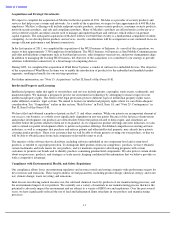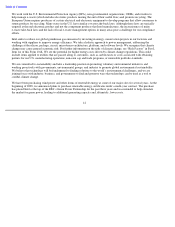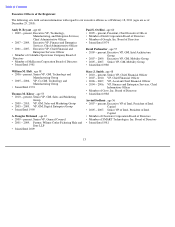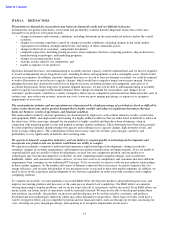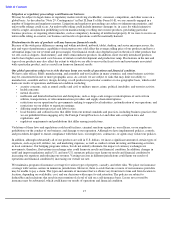Intel 2010 Annual Report Download - page 30
Download and view the complete annual report
Please find page 30 of the 2010 Intel annual report below. You can navigate through the pages in the report by either clicking on the pages listed below, or by using the keyword search tool below to find specific information within the annual report.
Table of Contents
Our results of operations could vary as a result of the methods, estimates, and judgments that we use in applying our
accounting policies.
The methods, estimates, and judgments that we use in applying our accounting policies have a significant impact on our results
of operations (see “Critical Accounting Estimates” in Part II, Item 7 of this Form 10-K). Such methods, estimates, and
judgments are, by their nature, subject to substantial risks, uncertainties, and assumptions, and factors may arise over time that
lead us to change our methods, estimates, and judgments. Changes in those methods, estimates, and judgments could
significantly affect our results of operations.
Decisions about the scope of operations of our business could affect our results of operations and financial condition.
Changes in the business environment could lead to changes in our decisions about the scope of operations of our business, and
these changes could result in restructuring and asset impairment charges. Factors that could affect our results of operations and
financial condition with regard to changing the scope of our operations include:
Our acquisitions, divestitures, and other transactions could disrupt our ongoing business and harm our results of
operations.
In pursuing our business strategy, we routinely conduct discussions, evaluate opportunities, and enter into agreements
regarding possible investments, acquisitions, divestitures, and other transactions, such as joint ventures. Acquisitions and other
transactions involve significant challenges and risks, including risks that:
When we decide to sell assets or a business, we may encounter difficulty in finding or completing divestiture opportunities or
alternative exit strategies on acceptable terms in a timely manner, and the agreed terms and financing arrangements could be
renegotiated due to changes in business or market conditions. These circumstances could delay the accomplishment of our
strategic objectives or cause us to incur additional expenses with respect to businesses that we want to dispose of, or we may
dispose of a business at a price or on terms that are less favorable than we had anticipated, resulting in a loss on the
transaction.
If we do enter into agreements with respect to acquisitions, divestitures, or other transactions, we may fail to complete them
due to factors such as:
In order to compete, we must attract, retain, and motivate key employees, and our failure to do so could harm our results of
operations.
In order to compete, we must attract, retain, and motivate executives and other key employees. Hiring and retaining qualified
executives, scientists, engineers, technical staff, and sales representatives are critical to our business, and competition for
experienced employees in the semiconductor industry can be intense. To help attract, retain, and motivate qualified employees,
we use share-based incentive awards such as non-vested share units (restricted stock units) and employee stock options. If the
value of such stock awards does not appreciate as measured by the performance of the price of our common stock, or if our
share-based compensation otherwise ceases to be viewed as a valuable benefit, our ability to attract, retain, and motivate
employees could be weakened, which could harm our results of operations.
18
•
timing and execution of plans and programs that may be subject to local labor law requirements, including consultation
with appropriate work councils;
•
changes in assumptions related to severance and postretirement costs;
•
future divestitures;
•
new business initiatives and changes in product roadmap, development, and manufacturing;
•
changes in employment levels and turnover rates;
•
changes in product demand and the business environment; and
•
changes in the fair value of certain long
-
lived assets.
•
we may not be able to identify suitable opportunities at terms acceptable to us;
•
the transaction may not advance our business strategy;
•
we may not realize a satisfactory return on the investment we make;
•
we may not be able to retain key personnel of the acquired business;
•
we may experience difficulty in integrating new employees, business systems, and technology;
• acquired businesses may not have adequate controls, processes, and procedures to ensure compliance with laws and
regulations globally, and our due diligence process may not identify compliance issues or other liabilities that are in
existence at the time of our acquisition;
•
we may have difficulty entering into new market segments in which we are not experienced; or
•
we may be unable to retain the customers and partners of acquired businesses following the acquisition.
•
failure to obtain required regulatory or other approvals;
•
intellectual property or other litigation; or
•
difficulties that we or other parties may encounter in obtaining financing for the transaction.


